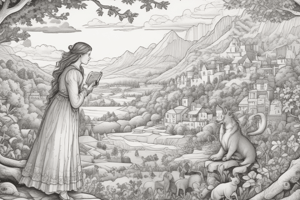Podcast
Questions and Answers
Match the type of imagery with its corresponding sense:
Match the type of imagery with its corresponding sense:
Visual Imagery = sight Auditory Imagery = hearing Tactile Imagery = touch Olfactory Imagery = smell
Match the function of imagery with its description:
Match the function of imagery with its description:
Creates a vivid experience = Establishes the tone and atmosphere Reveals character traits = Develops themes and symbolism Enhances descriptive language = Creates a vivid experience Establishes the setting = Reveals character traits
Match the type of imagery with its description:
Match the type of imagery with its description:
Visual Imagery = describes what the characters see Auditory Imagery = describes sounds or voices Tactile Imagery = describes textures or temperatures Gustatory Imagery = describes flavors or tastes
Match the step in analyzing imagery with its description:
Match the step in analyzing imagery with its description:
Match the sense appealed to with the type of imagery:
Match the sense appealed to with the type of imagery:
Match the aspect of literary analysis with its description:
Match the aspect of literary analysis with its description:
cool
vessel
prisoner
redeem
sting
achieve
threat
marathon
text
thick
cool vessel prisoner redeem sting achieve threat marathon text thick
Flashcards are hidden until you start studying
Study Notes
Imagery in Literary Analysis
Definition
- Imagery is a literary device used to create vivid sensory experiences for the reader
- It appeals to the reader's senses of sight, sound, touch, taste, and smell
Types of Imagery
- Visual Imagery: appeals to the sense of sight
- Describes what the characters see or what the setting looks like
- Auditory Imagery: appeals to the sense of hearing
- Describes sounds, voices, or music
- Tactile Imagery: appeals to the sense of touch
- Describes textures, temperatures, or sensations
- Olfactory Imagery: appeals to the sense of smell
- Describes scents, aromas, or odors
- Gustatory Imagery: appeals to the sense of taste
- Describes flavors, tastes, or textures of food and drink
Functions of Imagery
- Creates a vivid and immersive experience for the reader
- Establishes the tone and atmosphere of the story
- Reveals character traits, emotions, and motivations
- Develops themes and symbolism
- Enhances descriptive language and literary style
Analyzing Imagery in Literature
- Identify the type of imagery used (visual, auditory, etc.)
- Analyze the effect of the imagery on the reader's experience
- Examine how imagery relates to the themes, characters, and plot
- Consider the author's purpose in using imagery (e.g., to create mood, establish setting, etc.)
Imagery in Literary Analysis
Definition of Imagery
- Imagery is a literary device used to create vivid sensory experiences for the reader by appealing to the senses of sight, sound, touch, taste, and smell.
Types of Imagery
Visual Imagery
- Appeals to the sense of sight, describing what characters see or the setting's appearance.
Auditory Imagery
- Appeals to the sense of hearing, describing sounds, voices, or music.
Tactile Imagery
- Appeals to the sense of touch, describing textures, temperatures, or sensations.
Olfactory Imagery
- Appeals to the sense of smell, describing scents, aromas, or odors.
Gustatory Imagery
- Appeals to the sense of taste, describing flavors, tastes, or textures of food and drink.
Functions of Imagery
- Creates a vivid and immersive experience for the reader.
- Establishes the tone and atmosphere of the story.
- Reveals character traits, emotions, and motivations.
- Develops themes and symbolism.
- Enhances descriptive language and literary style.
Analyzing Imagery in Literature
- Identify the type of imagery used (visual, auditory, etc.).
- Analyze the effect of the imagery on the reader's experience.
- Examine how imagery relates to themes, characters, and plot.
- Consider the author's purpose in using imagery (e.g., to create mood, establish setting, etc.).
Studying That Suits You
Use AI to generate personalized quizzes and flashcards to suit your learning preferences.




